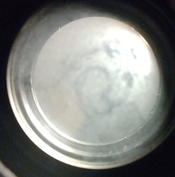indy_kid
Member
So, this is the view through the Taking lens of a Mamiya C Series 135mm. I had the lens out from the rest of the assembly, but the haze is between the last two elements, and the ring holding them is cemented in place.
Is there a solvent that will remove that cement, or is it usual to just cut the ring off, clean the glass, then put on a new ring?
It's not usable at this point.
Is there a solvent that will remove that cement, or is it usual to just cut the ring off, clean the glass, then put on a new ring?
It's not usable at this point.











